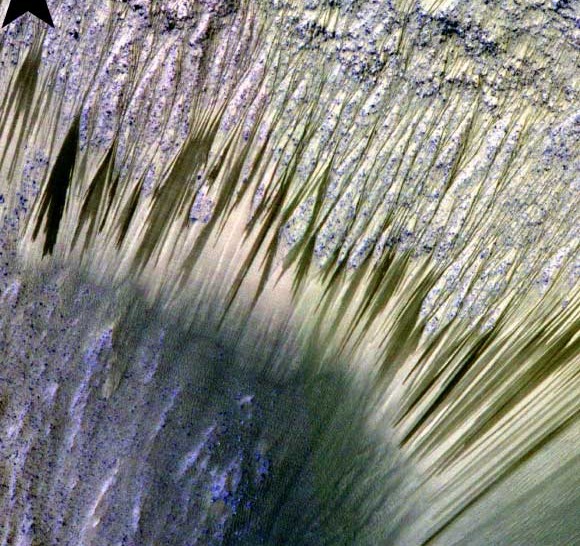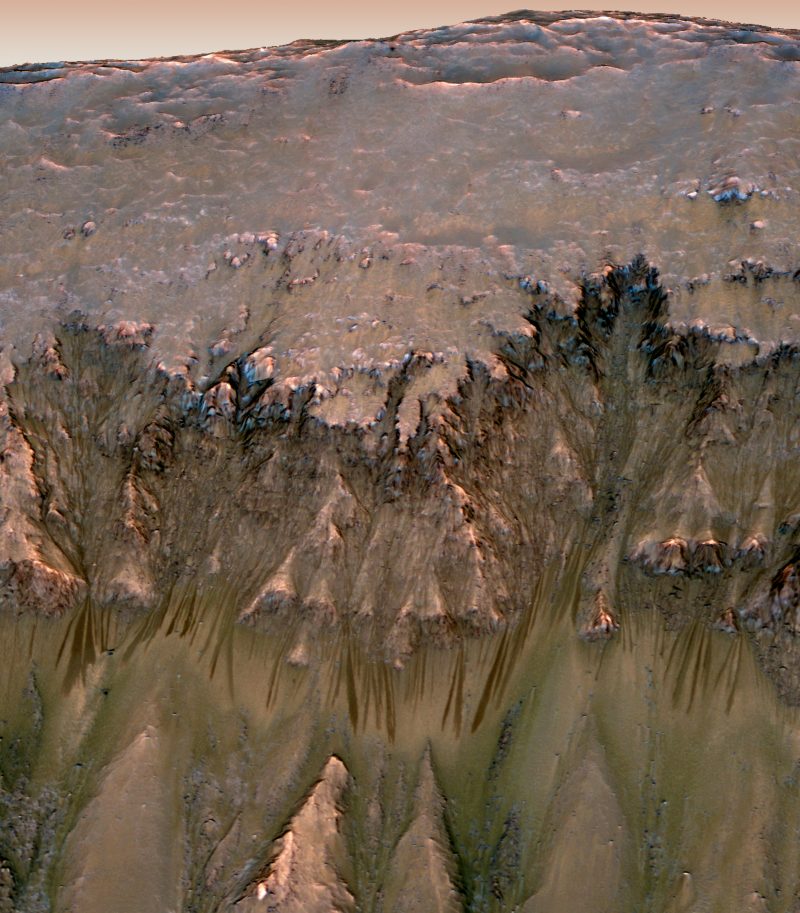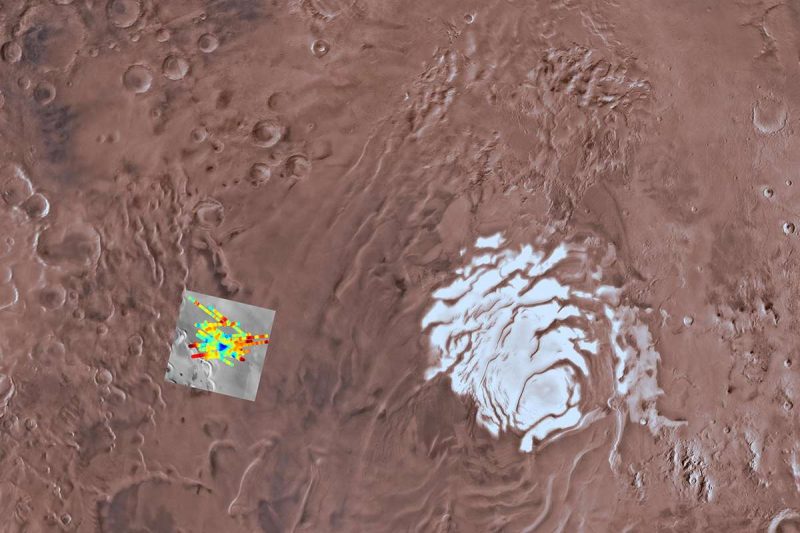

The long, thin dark streaks on the steep walls of this Martian crater are called “recurring slope lineae” by scientists. New research suggests they originate from deep groundwater. A collection of many additional images is available on the HiRISE website. Image via Mars Reconnaissance Orbiter/NASA/JPL/University of Arizona/Lujendra Ojha et al./Geophysical Research Letters.
Modern day observations of Mars – from decades of spacecraft exploration – show that its surface is very dry today, although Mars does have ice at its poles and below its surface. However, it’s widely believed Mars once had a lot of water, including rivers, lakes and maybe even oceans. Now, scientists from the USC Arid Climates and Water Research Center have presented tentative evidence for liquid water on Mars – pockets of groundwater deep below the surface in near-equatorial regions of the planet. The peer-reviewed study was published on March 28, 2019, in Nature Geoscience.
The new paper suggests that deep groundwater might be the cause of the unusual and mysterious long, dark streaks – called recurring slope lineae by scientists – seen on steep slopes of some Martian craters and canyons. Some scientists think they are created by small, brief flows of briny water. The recurring slope lineae aren’t permanent features; they tend to occur during warmer summer months in or near equatorial regions and then fade again when it’s colder. They’ve been observed to recur in the same locations in multiple years, hence the name.

Recurring slope lineae (RSL) on the walls of Newton Crater, imaged by Mars Reconnaissance Orbiter on May 30, 2011. Image via NASA/JPL-Caltech/University of Arizona.
The study suggests that recurring slope lineae in those regions are created by deep groundwater that comes up to the surface through tectonic and impact-related fractures in the ground. Other hypotheses have said these features might be caused by melting snows, shallow subsurface water flows closer to the surface, deliquescence or dry flows of sand/dust. According to USC research scientist Essam Heggy:
We suggest that this may not be true. We propose an alternative hypothesis that they originate from a deep pressurized groundwater source which comes to the surface moving upward along ground cracks.
The idea is that cracks in the surface in some craters allow water springs or aquifers deep below the surface – perhaps starting at some 2,500 feet (750 meters) – to rise up to the surface as a result of pressure. This water then leaks onto the surface, creating the sharp and distinct linear features found on the walls of some craters and canyons, including Valles Marineris, the Grand Canyon of Mars.
As also noted by co-author Abotalib Zaki:
The experience we gained from our research in desert hydrology was the cornerstone in reaching this conclusion. We have seen the same mechanisms in the North African Sahara and in the Arabian Peninsula, and it helped us explore the same mechanism on Mars.

The mysterious recurring slope lineae on Mars tend to cluster in the planet’s equatorial regions, where temperatures are the warmest. They disappear again when the weather cools. Image via Alfred S. McEwen et al./Nature GeoScience.
In 2018, researchers at the European Space Agency (ESA) announced that they had other evidence for liquid water: the tentative discovery of a large subsurface lake near Mars’ south polar cap. ESA’s Mars Express orbiter used ground-penetrating radar – the Mars Advanced Radar for Subsurface and Ionosphere Sounding instrument (MARSIS) – to detect the suspected lake below several layers of ice and dust. The ice deposit extends down about a mile (1.5 km). Beneath that deposit, radar images showed a bright spot within one 12-mile-wide (20-km-wide) region – indicative of liquid water, not just ice. From the paper:
The presence of liquid water at the base of the Martian polar caps has long been suspected but not observed. We surveyed the Planum Australe region using the MARSIS instrument, a low-frequency radar on the Mars Express spacecraft. Radar profiles collected between May 2012 and December 2015 contain evidence of liquid water trapped below the ice of the South Polar Layered Deposits. Anomalously bright subsurface reflections are evident within a well-defined, 20-kilometer-wide [12.5-mile-wide] zone centered at 193°E, 81°S, which is surrounded by much less reflective areas. Quantitative analysis of the radar signals shows that this bright feature has [characteristics matching] that of water-bearing materials.
We interpret this feature as a stable body of liquid water on Mars.
Similar lakes have been found below thick ice at the Earth’s poles, such as Lake Vostok in Antarctica.

First-ever liquid water lake discovered on Mars? The bright horizontal feature in this image represents Mars’ icy surface. The south polar layered deposits – layers of ice and dust – are seen to a depth of about a mile (1.5 km). Below is a base layer that in some areas is even brighter than the surface reflections, highlighted in blue. Analysis of the reflected signals suggests liquid water. Image via ESA/NASA/JPL/ASI/Univ. Rome; R. Orosei et al. 2018.
Finding groundwater on Mars today would help scientists better understand how Mars evolved over billions of years, and how similar that evolution was to Earth, as explained by Heggy:
Understanding how groundwater has formed on Mars, where it is today and how it is moving helps us constrain ambiguities on the evolution of climatic conditions on Mars for the last three billion years and how these conditions formed this groundwater system. It helps us to understand the similarities to our own planet and if we are going through the same climate evolution and the same path that Mars is going. Understanding Mars’ evolution is crucial for understanding our own Earth’s long-term evolution and groundwater is a key element in this process.
Groundwater is strong evidence for the past similarity between Mars and Earth – it suggests they have a similar evolution, to some extent.
Such depth requires us to consider more deep-probing techniques to look for the source of this groundwater versus looking for shallow sources of water.

Location of previous subsurface lake near Mars’ south pole (blue spot in the square), discovered by Mars Express in 2018. Image via USGS AstrogeologyScience Center/Arizona State University/INAF.
Evidence for a current body of subsurface liquid water near Mars’ south pole is exciting, but additional such lakes closer to the equator even more so, if they can be confirmed. They would increase the chances that some kind of life – even if likely just microbes – might exist deep underground on Mars, usually thought to be the most likely place to search anyway, given the hostile conditions on Mars’ surface. In regards to the south polar lake, Jeffery Plaut at NASA’s Jet Propulsion Laboratory in California noted in New Scientist that:
If the result is confirmed, it would be the largest known occurrence of present-day liquid water on Mars. It clearly has implications for the history of climate and the possibility of habitats suitable for life.
Bottom line: Does the cold desert world Mars have underground lakes? We still don’t know for certain, but this new paper from USC – in addition to the previous south polar discovery – provides more evidence that seems to say, yes.
Source: A deep groundwater origin for recurring slope lineae on Mars
from EarthSky https://ift.tt/2K0WlSJ


The long, thin dark streaks on the steep walls of this Martian crater are called “recurring slope lineae” by scientists. New research suggests they originate from deep groundwater. A collection of many additional images is available on the HiRISE website. Image via Mars Reconnaissance Orbiter/NASA/JPL/University of Arizona/Lujendra Ojha et al./Geophysical Research Letters.
Modern day observations of Mars – from decades of spacecraft exploration – show that its surface is very dry today, although Mars does have ice at its poles and below its surface. However, it’s widely believed Mars once had a lot of water, including rivers, lakes and maybe even oceans. Now, scientists from the USC Arid Climates and Water Research Center have presented tentative evidence for liquid water on Mars – pockets of groundwater deep below the surface in near-equatorial regions of the planet. The peer-reviewed study was published on March 28, 2019, in Nature Geoscience.
The new paper suggests that deep groundwater might be the cause of the unusual and mysterious long, dark streaks – called recurring slope lineae by scientists – seen on steep slopes of some Martian craters and canyons. Some scientists think they are created by small, brief flows of briny water. The recurring slope lineae aren’t permanent features; they tend to occur during warmer summer months in or near equatorial regions and then fade again when it’s colder. They’ve been observed to recur in the same locations in multiple years, hence the name.

Recurring slope lineae (RSL) on the walls of Newton Crater, imaged by Mars Reconnaissance Orbiter on May 30, 2011. Image via NASA/JPL-Caltech/University of Arizona.
The study suggests that recurring slope lineae in those regions are created by deep groundwater that comes up to the surface through tectonic and impact-related fractures in the ground. Other hypotheses have said these features might be caused by melting snows, shallow subsurface water flows closer to the surface, deliquescence or dry flows of sand/dust. According to USC research scientist Essam Heggy:
We suggest that this may not be true. We propose an alternative hypothesis that they originate from a deep pressurized groundwater source which comes to the surface moving upward along ground cracks.
The idea is that cracks in the surface in some craters allow water springs or aquifers deep below the surface – perhaps starting at some 2,500 feet (750 meters) – to rise up to the surface as a result of pressure. This water then leaks onto the surface, creating the sharp and distinct linear features found on the walls of some craters and canyons, including Valles Marineris, the Grand Canyon of Mars.
As also noted by co-author Abotalib Zaki:
The experience we gained from our research in desert hydrology was the cornerstone in reaching this conclusion. We have seen the same mechanisms in the North African Sahara and in the Arabian Peninsula, and it helped us explore the same mechanism on Mars.

The mysterious recurring slope lineae on Mars tend to cluster in the planet’s equatorial regions, where temperatures are the warmest. They disappear again when the weather cools. Image via Alfred S. McEwen et al./Nature GeoScience.
In 2018, researchers at the European Space Agency (ESA) announced that they had other evidence for liquid water: the tentative discovery of a large subsurface lake near Mars’ south polar cap. ESA’s Mars Express orbiter used ground-penetrating radar – the Mars Advanced Radar for Subsurface and Ionosphere Sounding instrument (MARSIS) – to detect the suspected lake below several layers of ice and dust. The ice deposit extends down about a mile (1.5 km). Beneath that deposit, radar images showed a bright spot within one 12-mile-wide (20-km-wide) region – indicative of liquid water, not just ice. From the paper:
The presence of liquid water at the base of the Martian polar caps has long been suspected but not observed. We surveyed the Planum Australe region using the MARSIS instrument, a low-frequency radar on the Mars Express spacecraft. Radar profiles collected between May 2012 and December 2015 contain evidence of liquid water trapped below the ice of the South Polar Layered Deposits. Anomalously bright subsurface reflections are evident within a well-defined, 20-kilometer-wide [12.5-mile-wide] zone centered at 193°E, 81°S, which is surrounded by much less reflective areas. Quantitative analysis of the radar signals shows that this bright feature has [characteristics matching] that of water-bearing materials.
We interpret this feature as a stable body of liquid water on Mars.
Similar lakes have been found below thick ice at the Earth’s poles, such as Lake Vostok in Antarctica.

First-ever liquid water lake discovered on Mars? The bright horizontal feature in this image represents Mars’ icy surface. The south polar layered deposits – layers of ice and dust – are seen to a depth of about a mile (1.5 km). Below is a base layer that in some areas is even brighter than the surface reflections, highlighted in blue. Analysis of the reflected signals suggests liquid water. Image via ESA/NASA/JPL/ASI/Univ. Rome; R. Orosei et al. 2018.
Finding groundwater on Mars today would help scientists better understand how Mars evolved over billions of years, and how similar that evolution was to Earth, as explained by Heggy:
Understanding how groundwater has formed on Mars, where it is today and how it is moving helps us constrain ambiguities on the evolution of climatic conditions on Mars for the last three billion years and how these conditions formed this groundwater system. It helps us to understand the similarities to our own planet and if we are going through the same climate evolution and the same path that Mars is going. Understanding Mars’ evolution is crucial for understanding our own Earth’s long-term evolution and groundwater is a key element in this process.
Groundwater is strong evidence for the past similarity between Mars and Earth – it suggests they have a similar evolution, to some extent.
Such depth requires us to consider more deep-probing techniques to look for the source of this groundwater versus looking for shallow sources of water.

Location of previous subsurface lake near Mars’ south pole (blue spot in the square), discovered by Mars Express in 2018. Image via USGS AstrogeologyScience Center/Arizona State University/INAF.
Evidence for a current body of subsurface liquid water near Mars’ south pole is exciting, but additional such lakes closer to the equator even more so, if they can be confirmed. They would increase the chances that some kind of life – even if likely just microbes – might exist deep underground on Mars, usually thought to be the most likely place to search anyway, given the hostile conditions on Mars’ surface. In regards to the south polar lake, Jeffery Plaut at NASA’s Jet Propulsion Laboratory in California noted in New Scientist that:
If the result is confirmed, it would be the largest known occurrence of present-day liquid water on Mars. It clearly has implications for the history of climate and the possibility of habitats suitable for life.
Bottom line: Does the cold desert world Mars have underground lakes? We still don’t know for certain, but this new paper from USC – in addition to the previous south polar discovery – provides more evidence that seems to say, yes.
Source: A deep groundwater origin for recurring slope lineae on Mars
from EarthSky https://ift.tt/2K0WlSJ

Aucun commentaire:
Enregistrer un commentaire